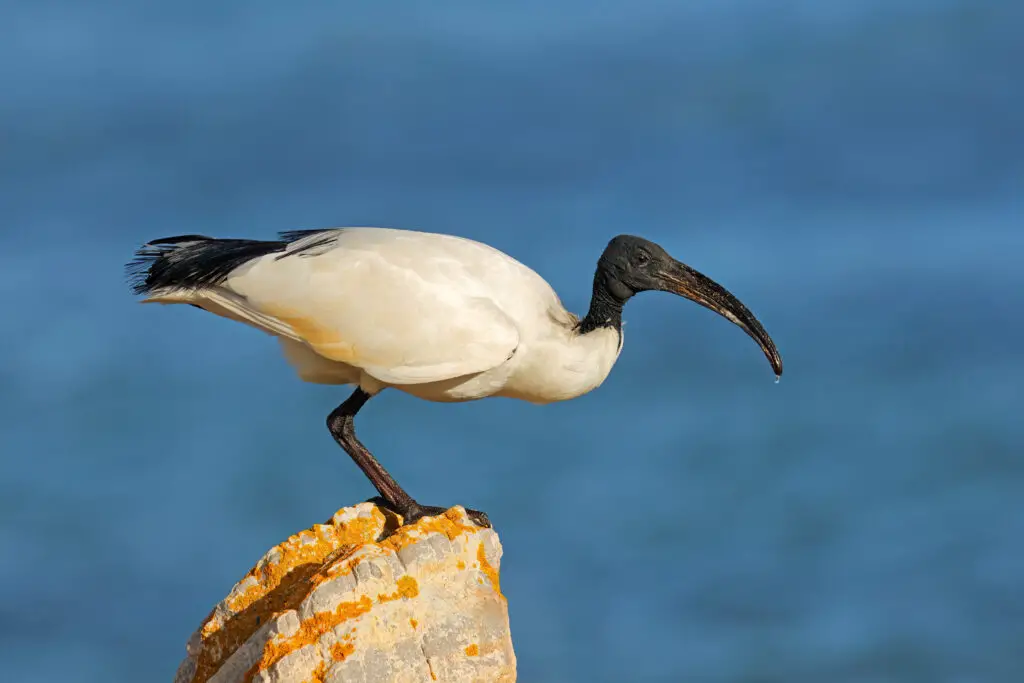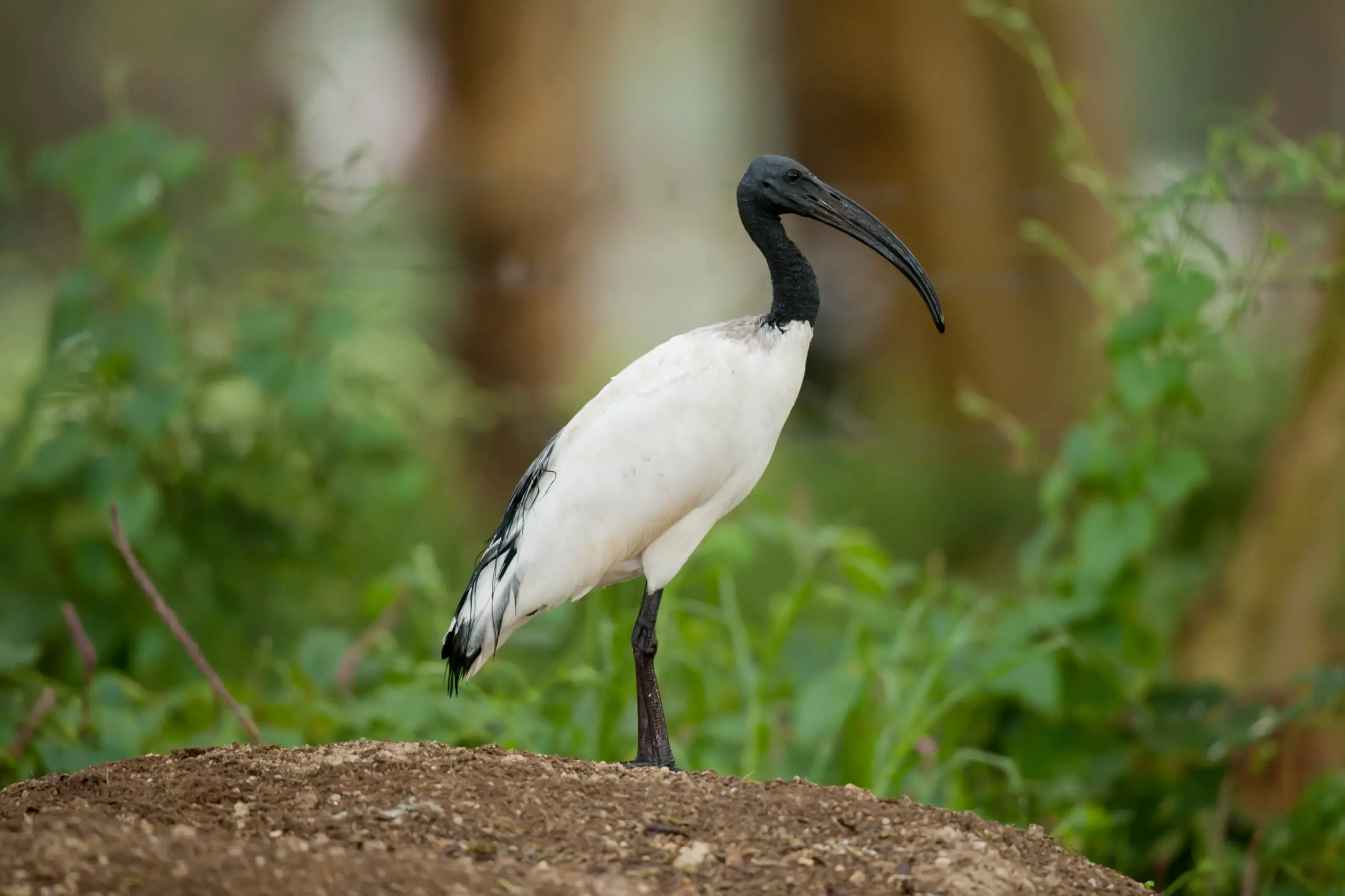The African sacred ibis, also known as Threskiornis aethiopicus, is a bird species that belongs to the family of Ibises and Spoonbills. It is widely distributed across sub-Saharan Africa, from Ethiopia in the east to Mauritania in the west.
This iconic bird has been an important part of various religious and cultural beliefs throughout history and continues to hold significant importance for many communities today. In ancient Egypt, the African sacred ibis was considered a symbol of wisdom and protection. They were often mummified and buried alongside pharaohs due to their association with the god Thoth, who was believed to be responsible for wisdom, writing, and magic.
The ibis’s long curved bill resembled a scribe’s pen, making it an apt representation of Thoth’s connection with language. Today, these birds are still revered by some cultures as symbols of good luck or used in traditional medicine practices due to perceived healing properties associated with them.
However, despite their cultural significance, they have faced numerous threats such as habitat loss and hunting which have resulted in declining populations over recent years.

Physical Characteristics And Habitat
The African sacred ibis is a bird species that belongs to the Threskiornithidae family. It measures approximately 65-75 cm in length and weighs up to 1.3 kg, with a wingspan of about 105-120 cm.
The plumage of adult birds is predominantly black, with glossy greenish-purple iridescence on its backside and neck, while its head, throat, and tail are naked or nearly so. Its long curved bill is also distinctive as it has a downward curve at the end.
This bird species can be found across Sub-Saharan Africa, from Senegal to Ethiopia and down to South Africa’s Southern Cape Province. They inhabit various environments such as savannas, wetlands, fields, grasslands, and even urban areas like golf courses and city parks. However, they prefer living near water bodies where there is abundant food supply like fish.
Dietary habits for these birds vary depending on their environment; however, they mainly feed on small animals such as insects (grasshoppers), reptiles (lizards), amphibians (frogs), crustaceans (crabs), mollusks (snails), worms but occasionally eat plant matter too.
Breeding behavior involves nesting during the dry season when water levels have receded enough not to flood nests built on trees or bushes above the ground level. During this time both male and female birds work together building the nest using sticks before laying two to three eggs which hatch after around twenty-eight days into chicks that fledge within six weeks of hatching.
Cultural Significance And Role In Ancient Egypt
The African sacred ibis holds a significant place in the religious beliefs and artistic representation of ancient Egypt. Its presence in various forms of art, including hieroglyphics, sculptures, and pottery, highlights its importance to the Egyptians.
The bird was considered sacred due to its association with Thoth, the god of wisdom, writing, and knowledge. In Egyptian mythology, it is believed that Thoth used the African sacred ibis as his messenger between Earth and heaven. This belief led to the bird being revered by the Egyptians and frequently depicted alongside Thoth in their artwork.
The Egyptians also believed that the ibis had healing powers and could cure diseases. Furthermore, the African sacred ibis played a role in mummification rituals during ancient times. It was often included in burials as an offering to ensure safe passage into the afterlife.
Today, this bird is still an important symbol for many cultures around Africa and continues to be celebrated for its cultural significance and contributions to ancient history.
Symbolism And Significance In Modern Times
The African sacred ibis has played a significant role in ancient Egyptian culture, but its symbolism and significance have continued to evolve over time.
Modern interpretations of the bird reflect its enduring importance as an iconic symbol of Egypt and its cultural heritage.
In contemporary artistic representations, the African sacred ibis is often depicted as a powerful emblem of power and mystique.
Its sleek black plumage and distinctive curved beak lend it an air of regal dominance that speaks to both the bird’s historical status as a revered religious icon and its current relevance as a potent cultural symbol.
Despite changes in interpretation over time, the African sacred ibis remains one of the most recognizable symbols associated with Egypt today.
Whether celebrated for its spiritual significance or admired for its aesthetic appeal, this majestic bird continues to inspire awe and reverence among people around the world.
Threats To African Sacred Ibis Populations
Human interference and habitat loss have been significant threats to African Sacred Ibis populations across their range. As human settlements expand, the ibis’s natural habitats are being destroyed or degraded.
The conversion of wetlands for agriculture, urbanization, and industrial development has led to a decline in suitable breeding sites. Furthermore, human activities such as illegal hunting, egg collection, and disturbance during nesting seasons pose additional challenges to these birds’ survival.
The demand for ibis feathers used in traditional costumes and rituals has also contributed to population declines. The negative impact of human interference on African Sacred Ibis populations highlights the urgent need for conservation measures.
Measures that conserve wetland habitats through land-use planning policies and regulations can help mitigate this threat. Additionally, educating communities about the ecological importance of these birds may inspire local support for conservation efforts aimed at preserving their populations.
Conservation Efforts To Protect The Species
Conservation efforts to protect the African sacred ibis have gained momentum over the years. The bird species has been listed as a protected species in most countries, and measures are being put in place to prevent its decline.
Community involvement is a crucial aspect of these conservation efforts, with local communities playing an active role in protecting the birds and their habitats.
To complement community involvement, governments have also implemented various policies aimed at safeguarding the African sacred ibis’ survival. These policies range from habitat protection to banning hunting or trading of the bird species and promoting environmental education initiatives. Governments work together with relevant stakeholders such as non-governmental organizations (NGOs) and international bodies like the Convention on International Trade in Endangered Species (CITES) to ensure that these policies are enforced effectively.
While significant progress has been made towards conserving the African sacred ibis, more needs to be done if this beautiful bird species is to avoid extinction.
There is still a need for continued collaboration between governments, NGOs, local communities, and other stakeholders involved in conservation efforts. Furthermore, there is a need for increased funding towards research geared towards understanding better ways of preserving this iconic bird species.
Only by working together can we ensure that future generations get to marvel at the beauty of the African sacred ibis for years to come.

Future Outlook For African Sacred Ibis Populations
As conservation efforts are being implemented to protect the African Sacred Ibis, it is important to look towards the future outlook for their populations.
Population trends have shown a decline in recent years due to habitat loss and human interference.
With continued destruction of wetland habitats and urbanization, the species faces an uncertain future.
Habitat loss has been identified as one of the major threats facing the African Sacred Ibis.
Wetlands provide an essential breeding ground for these birds, but they are rapidly disappearing due to agricultural activities and land development projects.
As water resources become scarce, wetland areas are often drained or converted into farmland or industrial sites.
In addition, urbanization results in pollution that contaminates their food sources and negatively affects their reproductive success.
Overall, there is cause for concern regarding the future of African Sacred Ibis populations.
While conservation efforts may slow down population declines, more action needs to be taken in order to prevent further habitat loss and ensure sustainable populations.
The cooperation between local communities, governments and non-governmental organizations is crucial in protecting this iconic bird species from extinction.
Conclusion
The African Sacred Ibis is a bird species with significant cultural and ecological importance. Despite its widespread distribution across Africa, the population of this bird has been declining due to habitat loss, hunting, and other human activities.
In response to these threats, conservation efforts have been implemented to protect the African Sacred Ibis populations. However, more needs to be done in terms of monitoring their habitats and raising public awareness about the significance of maintaining biodiversity.
It is crucial that we understand the role of each species in our ecosystem and work towards preserving them for future generations. By protecting species such as the African Sacred Ibis, we can ensure a healthy and sustainable environment for all living organisms on Earth.


